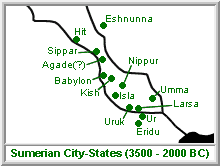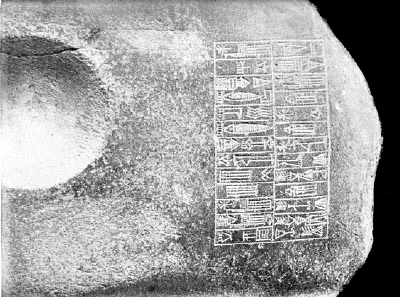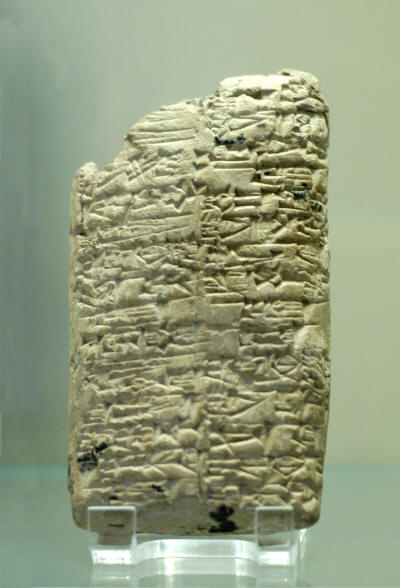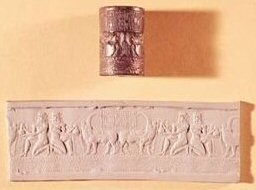| The Kingdom of Akkad (2234-2154 BC) |
 |
|
The Akkadian Empire usually refers to the Semitic speaking state that grew
up around the city of Akkad north of Sumer, and reached its greatest
extent under Sargon of Akkad. Although ascertaining exact dates during
this period is subject to significant disagreement, the Akkadian Empire
lasted from circa 2350 BC to 2150 BC—approximately 200 years. History Rulers with Semitic names had already established themselves at Kish. One of them, contemporary with the last Sumerian ruler, Lugal-Zage-Si, was Alusarsid (or Urumus) who "subdued Elam and Barahs." But the fame of these early establishers of Semitic supremacy was far eclipsed by that of Sargon (Sharru-kin), who defeated and captured Lugal-Zage-Si, conquering his empire. A lengthy inscription of Sargon's son, Manishtushu, was discovered at Susa by J. de Morgan. The date of Sargon is placed by modern scholars around 2300 BC (although the later "archaeologist king" of Babylonia, Nabonidus, calculated it at 3800 BC). Sargon was the son of La'ibum or Itti-Bel, and one legend related how he had been born in concealment and set adrift in an ark of bulrushes on the waters of the Euphrates. Here he was rescued and brought up by "Akki the husbandman"; but the day arrived at length when his true origin became known. Originally a cupbearer to a king of Kish with a Semitic name, Ur Zababa, the crown was set upon Sargon's head, and he entered upon a career of foreign conquest. Four times he invaded Syria and Canaan, and spent three years thoroughly subduing the countries of "the west" to unite them with Mesopotamia "into a single empire." Images of Sargon were erected on the shores of the Mediterranean in token of his victories, and cities and palaces were built at home with the spoils of the conquered lands. Elam and the northern part of Mesopotamia were also subjugated, and rebellions were put down Sumer itself. Contract tablets have been found dated in the years of the campaigns against Canaan and Sarlak, king of Gutium nowadays North Iraq; and copper is mentioned as being brought from Magan (probably modern Oman). Sargon's two sons and successors, Rimush and Manishtushu, were not so illustrious, and both were assassinated; but his grandson, Naram-Sin, followed up the earlier successes by marching into Magan, whose king he took captive. He assumed the imperial title of "King Naram-Sin, of the four quarters", and, like his grandfather, was addressed as "the god of Agade" (Akkad), reminiscent of the divine honours claimed by the Pharaohs of Egypt. Art A finely executed bas relief representing Naram-Sin, and bearing a striking resemblance to early Egyptian art in many of its features, has been found at Diarbekr, in modern Turkey. Babylonian art, however, had already attained a high degree of excellence; two cylinder seals of the time of Sargon are among the most beautiful specimens of the gem-cutter's art ever discovered. Achievements The empire was bound together by roads, along which there was a regular postal service. Clay seals that took the place of stamps bear the names of Sargon and his son. A cadastral survey seems also to have been instituted, and one of the documents relating to it states that a certain Uru-Malik, whose name appears to indicate his Canaanite origin, was governor of the land of the Amorites, or Amurru as the semi-nomadic people of Syria and Canaan were called in Akkadian. It is probable that the first collection of astronomical observations and terrestrial omens was made for a library established by Sargon. Naram-Sin recorded the Akkadian's wars against the Armani or Armeni people in Ararat. The Armeni is a reference to Armen who was the ruler of the Armenian tribe (Armen's followers, the Armenians [Uraštu in Akkadian language], were referred to as Armeni or Armens at the time). It is also unknown if Sargon, grandfather of Naram-Sin, and Manishtushu, father of Naram-Sin, also fought against the Armeni people of Ararat during their rule of the Akkadian Empire. It is highly probable however considering that Naram-Sin recorded multiple wars with the Armeni people of Ararat. It is still unknown at this time if the wars with the Armeni people of Ararat contributed to the collapse of the Akkadian kingdom. However, the Akkadian Empire was already starting to crumble during Shar-kali-sharri's reign, the son of Naram-Sin, and by the end of Shar-kali-sharri's reign, the Akkadian Empire collapsed outright from the invasion of barbarians of the Zagros known as "Gutians". After the Akkadian Empire The fall of the empire established by Sargon seems to have been as sudden as its rise, and little is known about the Gutian period. From the fall of Akkad until around 2100 BC, there is much that is still dark. A relatively well known king from that period is Gudea, king of Lagash. The period between ca. 2100 BC and 2000 BC is sometimes called the 3rd dynasty of Ur or "Sumerian Renaissance", founded by Ur-Nammu (originally a general). Though documents again began to be written in Sumerian, this dynasty may actually have been Semitic; Sumerian was becoming a dead language, much as Latin later would be in Medieval Europe. The power of these kings extended to the Mediterranean. After the fall of the Ur III dynasty owing to an Elamite invasion in 2004 BC, Mesopotamia passed under foreign influence. This period is called Old Babylonian, and lasted from ca. 2000 BC until 1595 BC. During the first centuries of this period, kings and people in high position often had Amorite names, and supreme power rested at Isin. The city of Babylon was given hegemony over Mesopotamia by king Hammurabi 1792 BC - 1750 BC (dates highly uncertain). References This article incorporates text from the Encyclopædia Britannica Eleventh Edition, a publication now in the public domain. |
|
|
|
|
| Kings of Akkad | |
|
Sargon (56) 2334-2279 BC |
|
|
Was Sargon also King Nimrod of the bible In 2334 B.C. an invasion occurred in Mesopotamia. The Akkadian speaking people led by a man named Sargon conquered the Sumerians. Sargon founded a powerful dynasty. Sargon conquered other territories as well. He overcame cities in the mountains of southern Anatolia. This gave him access to rich silver mines. Elam (in the southwest portion of what is now Iran) also came under Sargon's rule. Sargon also brought city states in northern Syria under his domination. The empire that he established was indeed powerful. This is ironic, since he is said to have come from an origin that was very humble. The story goes that he was raised by a gardener who allegedly found him found him floating in a basket on a river. Sargon took up the gardening profession for a while. Sargon's father was a gardener, the cupbearer of Ur-Zababa, the king (first emperor) of Agade, who built Agade. |
|
|
Rimush (9) 2279-2270 |
|
|
After Sargon died, his son Rimush became king. Rimush ruled
until 2270 B.C. He was highly unpopular because of the violent way that
he dealt with opposition. His own servants assassinated him.
List of the victories of Rimush, king of Akkad, upon Abalgamash, king of Marhashi, and upon Elamite cities. Clay tablet, copy of a monumental inscription, ca. 2270 BC.
|
|
|
Man-Ishtishu (15) 2270-2255 |
|
|
Rimush's brother Manishtu ascended the throne. He restored
order in vassal states that had revolted. Manishtu enhanced the military
strength by building a navy. Then he led a campaign to the banks of the
Persian Gulf and put down uprisings by the new vassal states of Ansham
and Sherihum. Manishtu did not stop there. He went down the resources
that came under his control. Manishtu also took many blocks of diorite
(a black volcanic rock) and one was used to make a statue of him. It was
placed in the temple of Enlil at Nippur.
|
|
|
Naram-Sin (56) 2255-2219 BC |
|
|
In 2254 B.C. Manishtu died and his son Naram-Sin took the
throne. He declared himself to be a god and ordered that the cuneiform
star sign (the sign of the gods) precede his name.Naram-Sin conquered
the cities of Arman and Ebla and laid waste to them. They were later rebuilt. Naram-Son also led a military campaign against the Lullibis, a tribe in the northwest part of what is now Iran. The Lullubis had been robbing caravans. Another conquest of Naram-Sin was in Lebanon. He took control of Amanus, which gave him access to a rich source of timber, i.e. cedars. During the reign of Naram-Sin, the Elamite governor, Puzur Inshushinak remained a vassal of Naram-Sin. |
|
|
Shar-kali-sharri (24) 2217-2193BC |
|
| In 2217 Naram-Sin died and
Shar-Kulli-Sharri became king. The empire weakened. Puzur Inshushinak
invaded two vassal states and even led his army deep into Akkad itself.
Invasions by the Amorites and the troops of Martu occurred. After
Shar-Kulli-Sharri died in 2193 B.C. things got far worse. The Gutians
invaded Akkad and the dynasty that Sargon had founded collapsed. The
temple of Ishtar at Assur was destroyed and the royal palace at Agade
was sacked. However, the Sumerian cities (Ur, Nippur, Uruk, Lagash, etc.) remained intact during the period of Gutian domination and actually prospered. The Gutian rule ended in 2123 B.C. The ruler of the Sumerian city of Uruk was Utu-Hegal ('Lugal'). He overthrew the Gutians and cast off their yoke forever. His first act in doing this was imprisoning the ambassadors of Tirqan, the Gutian king. Thus Utu-Hegal founded the neo-Sumerian dynasty. However, the Akkadians eventually regain control of Mesopotamia.

Here is a close-up, partial view of a stone door socket found by John Peters near the ziggurat at Nippur. For his description of door-sockets see Door-sockets: weighty inscriptions in the temple. The doorpost turned in a shallow, hollowed out spot in the middle of the stone block. A second door-socket was also found. The two inscribed stone blocks originally flanked the main entrance to the Enlil temple constructed by King Shar-kali-sharri (2217-2193 B.C.). The work was actually begun, but not finished, by his father, King Naram-Sin (2254-2218). The ziggurat itself was not built until later by Ur-Nammu (2112-2095 B.C.). This inscription of Shar-kali-sharri, king of Akkad, is written in Akkadian with some Sumerian words as logograms (word-signs). It can be read as follows, with commas separating each line or case.
This column (excluding the last line) can be translated: Enlil revealed (that is, gave approval and instruction by divinatory sign). Shar-kali-sharri, the Mighty, the King of Agade, the Builder of Ekur, Enlil's temple in Nippur.
This column (beginning with the last line of column one) can be translated: Whoever removes this inscription, may Enlil, Utu and Inanna tear out his foundation and destroy his progeny.
|
|
|
Igigi (2) 2192-2190BC |
|
After his reign, there seems to
have been a short period of chaos: The list of kings states:
|
|
|
Nanijum (-1) 2190-2189BC |
|
After his reign, there seems to
have been a short period of chaos: The list of kings states:
|
|
|
Imi (-1) 2190-2189BC |
|
After his reign, there seems to
have been a short period of chaos: The list of kings states:
|
|
|
Elulu (-1) 2190-2189BC |
|
After his reign, there seems to
have been a short period of chaos: The list of kings states:
|
|
|
Dudu (20) 2189-2169BC |
|
|
Shu-Turul (14) 2168-2154BC |
|
| Shu-turul (Shu-durul) was a king of Akkad from 2168 to 2154BC. He was preceded by Dudu. He was the last king of Akkad according to the Sumerian king list. Akkad was conquered and the capital was moved back to Erech at the end of his reign. | |

